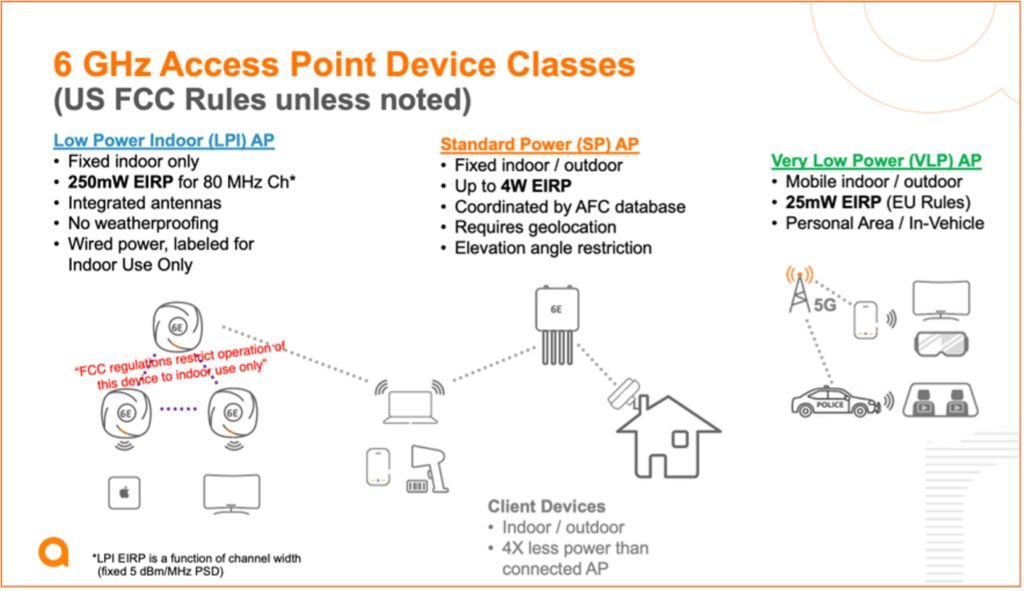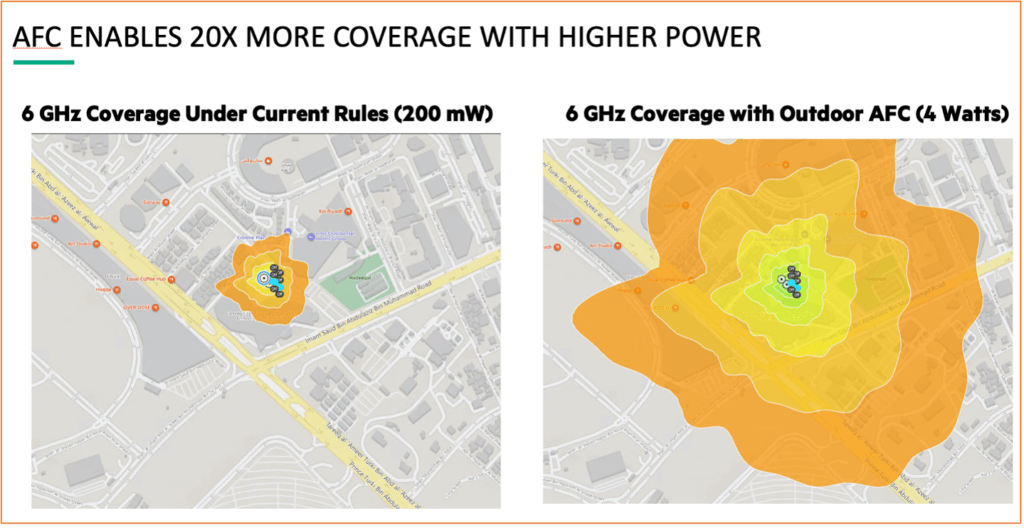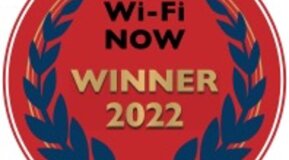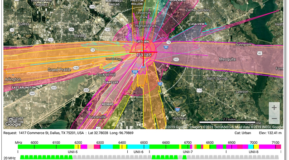What will Wi-Fi 6E Standard Power enable?
As we consider the significance of the CITC AFC and Standard Power demonstration, it’s important to remember that there are three primary AP device classes that are being introduced in the 6 GHz band – Low Power Indoor (LPI), Very Low Power (VLP), and Standard Power – with variations from country to country on which of these device classes are being authorized.

LPI is the common denominator across all 53 countries that have thus far opened the 6 GHz band for unlicensed, and the large majority of the devices and deployments to date are LPI, which satisfy most indoor uses. Standard Power will be required for 1) outdoor operations, 2) when connectorized antennas are utilized, or 3) any time that higher power is required (the current LPI limit in the US is 5 dBm/MHz, translating to 250 mW in an 80 MHz wide channel). Important Standard Power use cases include: outdoor/open air stadiums, transport and logistics facilities, manufacturing plants, agricultural, rural broadband, campus coverage, municipal Wi-Fi, enhanced indoor coverage, and the like.
In order for 6 GHz to fulfill the same range of enterprise use cases that 5 GHz does today, we will need both LPI and Standard Power operations. (And VLP is needed to address other important Wi-Fi use cases such as personal hotspots, in-vehicle connectivity, wearables, etc.)
Wi-Fi 6E: LPI and Standard Power
As an example of the difference in coverage possible with LPI and Standard Power, below is the estimated coverage of a 20 MHz 6 GHz channel using the current CITC Saudi Arabia LPI limit of 23 dBm EIRP (on the left) and the 36 dBm EIRP Standard Power limit (on the right). [Note that this modeling is a straightforward comparison of relative EIRPs (i.e., it disregards the Building Exit Loss that would apply to the LPI signals – further constraining the coverage for LPI.]

Global Activity on AFC and Wi-Fi 6E Standard Power
The timing of the CITC AFC demonstration was also quite appropriate given the amount of concurrent activity going on in countries around the world to complete the respective regulatory processes needed to authorize 6 GHz Standard Power operation and AFC services. Here’s a summary of where things stand in some of the leading countries and regions, with a focus on the US as the epicenter for the industry efforts thus far.
United States
The FCC solicited proposals from entities seeking to become approved AFC System Operators. Fourteen proposals were filed by the November 30, 2021 deadline. The 14 AFC operator proposals exceeded the combined number of initial proposals that the FCC received to become TVWS database and CBRS SAS operators, highlighting the diverse appeal for AFC solutions and 6GHz Standard Power.
The 14 proposals were filed by:

Aruba was pleased to see such a large, diverse, and distinguished group of companies and organizations putting their collective efforts into AFC commercialization. Even a cursory review of this list reveals participation from the leading Wi-Fi chipset manufacturers, the cable and residential Wi-Fi sectors, the enterprise Wi-Fi market, two leading Wi-Fi ecosystem associations, companies with deep cellular expertise (important for the 5G NR-U opportunity), and virtually all of the leading companies in geolocation databases for spectrum management (eight of the 14 applicants are approved CBRS SAS administrators, with Nokia being conditionally approved for SAS services). Taking a closer look at the proposals, you’ll see that there was almost universal support for the industry standards and specifications that have been developed by the WInnForum and Wi-Fi Alliance, with 13 of the 14 applicants stating that they will implement the Wi-Fi Alliance’s AFC SDI specification.
The FCC’s next step will likely be to grant conditional approval for the AFC applicants who have demonstrated their readiness to begin a period of lab testing along with a phase of public demonstrations and trials (each proposal included details about how the AFC applicants would make their systems available during this public examination phase). In parallel, industry is finalizing the specifications and work products necessary to conduct the lab and field testing. Aruba continues to be heavily involved in these efforts.
Canada
Canadian regulator ISED indicated in its May 2021 6 GHz Decision that it would authorize Standard Power and AFC in the future, while immediately authorizing LPI and VLP (Canada holds the distinction of being the first country to authorize all three device classes). ISED just solicited industry responses to consultations on AFC and Standard Power, with responses due July 15. We next expect ISED to put forward its plans to finalize both the AFC and Standard Power device approval processes in the coming months.
Republic of Korea
South Korean regulator MSIT was the second to conditionally authorize 6 GHz Standard Power operations when it opened the band for unlicensed services in October 2020. MSIT has indicated its intent to authorize Standard Power outdoor operations under the coordination of an AFC-like database in 2022.
Kingdom of Saudi Arabia
Having hosted the first end-to-end demonstration of AFC coordination of Wi-Fi access points, the Saudi regulator CITC intends to finalize its rules for Standard Power operation and AFC service delivery in the Kingdom in the coming months.
European Union
In June 2022, the CEPT’s Electronic Communications Committee (ECC) approved a work item to study the feasibility of higher power RLAN operations (up to 4W EIRP) in the 6 GHz band utilizing a “dynamic spectrum access coordination function,” which presumably will provide similar capabilities to AFC systems.
Brazil
Brazilian regulator Anatel has recently indicated that it intends to move quickly to authorize Standard Power operations with AFC coordination.
Other Countries
Recognizing the important use cases enabled by 6 GHz Standard Power, a number of other countries have solicited industry input on Standard Power, higher power operations, and AFC – either as components of their general consultations on 6 GHz unlicensed or as dedicated consultations. For example, Mexican regulator IFT conducted a focused consultation on Systems for Automated Frequency Coordination (SAFC) at the beginning of 2022, after having conducted a more general consultation on 6 GHz unlicensed during 2021. In the Asia-Pacific region, Australian regulator ACMA and Malaysian regulator MCMC both asked specific questions about Standard Power and AFC within their general consultations on 6 GHz unlicensed.
The key takeaway from all of this is that there is a great deal of activity in countries and regions around the world to authorize Standard Power and AFC. It will be fascinating to see which country is first to do so.
Additional resources




